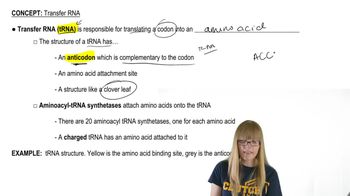Describe the purpose of the Ames test. How are his⁻ bacteria used in the Ames test? What mutational event is identified using his⁻ bacteria?
Table of contents
- 1. Introduction to Genetics51m
- 2. Mendel's Laws of Inheritance3h 37m
- 3. Extensions to Mendelian Inheritance2h 41m
- 4. Genetic Mapping and Linkage2h 28m
- 5. Genetics of Bacteria and Viruses1h 21m
- 6. Chromosomal Variation1h 48m
- 7. DNA and Chromosome Structure56m
- 8. DNA Replication1h 10m
- 9. Mitosis and Meiosis1h 34m
- 10. Transcription1h 0m
- 11. Translation58m
- 12. Gene Regulation in Prokaryotes1h 19m
- 13. Gene Regulation in Eukaryotes44m
- 14. Genetic Control of Development44m
- 15. Genomes and Genomics1h 50m
- 16. Transposable Elements47m
- 17. Mutation, Repair, and Recombination1h 6m
- 18. Molecular Genetic Tools19m
- 19. Cancer Genetics29m
- 20. Quantitative Genetics1h 26m
- 21. Population Genetics50m
- 22. Evolutionary Genetics29m
17. Mutation, Repair, and Recombination
Types of Mutations
Problem 11c
Textbook Question
Two different mutations are identified in a haploid strain of yeast. The first prevents the synthesis of adenine by a nonsense mutation of the ade-1 gene. In this mutation, a base-pair substitution changes a tryptophan codon (UGG) to a stop codon (UGA). The second affects one of several duplicate tRNA genes. This base-pair substitution mutation changes the anticodon sequence of a tRNAᵀʳᵖ from
3′−ACC−5′ to 3′−ACU−5′
Assuming there are no other mutations in the genome, will this double-mutant yeast strain be able to grow on minimal medium? If growth will occur, characterize the nature of growth relative to wild type.
 Verified step by step guidance
Verified step by step guidance1
Understand the first mutation: The nonsense mutation in the ade-1 gene changes a tryptophan codon (UGG) to a stop codon (UGA). This prevents the synthesis of adenine, which is essential for yeast growth on minimal medium. Without adenine, the yeast cannot grow unless the mutation is suppressed or adenine is supplemented.
Analyze the second mutation: The second mutation alters the anticodon of a tRNAᵀʳᵖ from 3′−ACC−5′ to 3′−ACU−5′. This change allows the tRNA to recognize the stop codon UGA and insert tryptophan during translation, potentially suppressing the nonsense mutation in the ade-1 gene.
Determine the effect of the second mutation: The modified tRNAᵀʳᵖ can suppress the nonsense mutation by inserting tryptophan at the UGA stop codon. This suppression may restore the production of a functional Ade-1 protein, enabling adenine synthesis.
Evaluate the growth of the double-mutant strain: If the suppression is effective, the double-mutant yeast strain will be able to synthesize adenine and grow on minimal medium. However, the growth may not be as robust as the wild type due to potential inefficiencies in suppression or other cellular effects of the modified tRNA.
Characterize the nature of growth: If growth occurs, it is likely to be slower or less efficient than the wild type because the suppression mechanism is not perfect, and the modified tRNA may interfere with normal translation processes. This would result in a phenotype that is partially rescued relative to the wild type.
 Verified video answer for a similar problem:
Verified video answer for a similar problem:This video solution was recommended by our tutors as helpful for the problem above
Video duration:
1mPlay a video:
Was this helpful?
Key Concepts
Here are the essential concepts you must grasp in order to answer the question correctly.
Nonsense Mutation
A nonsense mutation is a type of point mutation where a single nucleotide change results in a premature stop codon in the coding sequence of a gene. This leads to the truncation of the protein, often rendering it nonfunctional. In the context of the ade-1 gene in yeast, the mutation prevents the synthesis of adenine, which is essential for growth on minimal medium.
Recommended video:
Guided course

Point Mutations
tRNA and Anticodon
Transfer RNA (tRNA) is a type of RNA molecule that helps decode a messenger RNA (mRNA) sequence into a protein. Each tRNA has an anticodon that pairs with a corresponding codon on the mRNA. The mutation described changes the anticodon of a tRNAᵀʳᵖ, which may affect the translation of specific amino acids, potentially impacting protein synthesis and cellular function.
Recommended video:
Minimal Medium Growth
Minimal medium is a growth medium that contains only the essential nutrients required for the growth of an organism, such as carbon sources, salts, and a nitrogen source. For yeast to grow on minimal medium, it must be able to synthesize all necessary metabolites, including adenine. The presence of the nonsense mutation in the ade-1 gene suggests that the double-mutant strain may not be able to grow on minimal medium unless the tRNA mutation compensates for the loss of adenine synthesis.
Recommended video:
Guided course

Conjugation Overview
Related Videos
Related Practice
Textbook Question
578
views



